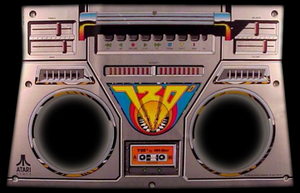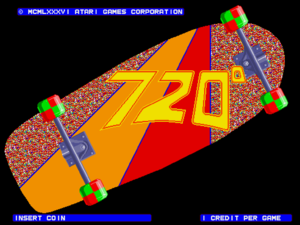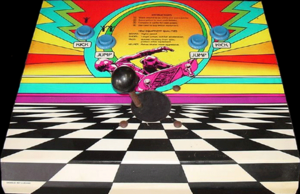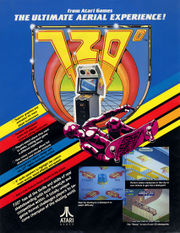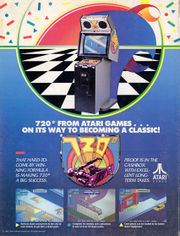Lost In Translation/720 Degrees
| 720 Degrees | |
|---|---|
| Manufacturer | Atari Games |
| Released | 1986 |
| Control Method |
Analog joystick 2 Button(s) |
| Main CPU | T11 (@ 10.000 MHz) M6502 (@ 2.200 MHz) |
| Sound CPU | Stereo YM2151 (@ 3.580 MHz) (2x) POKEY (@ 1.790 MHz) TMS5220 (@ 625.000 kHz) |
| Video Details |
Raster (Horizontal) 512 x 384 pixels 60.00 Hz 256 Palette colours |
| Screens | 1 |
| ROM Info | 36 ROMs 1,802,240 bytes (1.72 MiB) |
| MAME ID | 720 · 720g · 720gr1 · 720r1 · 720r2 · 720r3 |
About The Game
720° (or 720 Degrees) is a skateboard-themed arcade video game with both competitive and street-style skating action.
The player portrays the skater who performs skate manoeuvres for points and competes in skate parks for medals. The action takes place in a Skate City where all surfaces are skate-able. Players can choose where they want to skate in the city, and which skate parks they want to enter, making each new game a different experience.
At the start of each game, players can select one of two play modes. A training game is available for beginning players. In this game, there are numerous playing hints and messages, and the add-a-coin feature is disabled. Experienced players can start off by skating to a higher platform. Fewer game hints are given in this mode, and the add-a-coin feature is offered.
Game play starts with the player in the middle of Skate City. Using a new rotary control and a jump and a Kick button, players manoeuvre around the city trying to score points by performing skilful skate moves. At various score thresholds, skate park tickets are rewarded. These tickets allow entry into one of the skate parks, where players compete against the clock for gold, silver or bronze medals.
The player's main objective is to compete in as many skate parks as possible. In the city streets, players have a limited amount of time to win entry tickets and make their way to a skate park. In addition, there are numerous city hazards which must be avoided such as BMX riders, cars, Frisbee throwers, and other gangs. To guide the player in the city, players find map areas in streets which momentarily display the layout of the city and the location of the skate parks.
In 720° there are ten class levels which determine the degree of difficulty in the skate parks and the timer in the streets. Players select the class level in which they want to compete. For instance, at the start of each game, there are four unique skate parks which are located in the outskirts of the city. Each park is a different class ranging from class 1 difficulty, which is the easiest, to class 4 difficulty, the hardest.
In 720° players can compete in over 20 different skate parks. Each one requires unique skill moves to qualify for a medal. There are variations of a half-pipe ramp, a downhill; a slalom and a jump park. Each skate park has a distinct music score of its own, creating a different mood for players.
In the skate parks, cash prizes arc awarded to players that qualify for a medal. After each skate park competition, the game continues hack in the city for more street-style skating. Players can use their cash winnings to buy equipment from various skate shops which are located throughout the city. Skating equipment helps players perform better moves. Boards give faster speed. Helmets allow more risk-taking for successful manoeuvres. Pads give faster recovery from falls. Shoes provide more height on jumps and quicker starts. As a reference for locating skate shops and park entrances, players find map areas throughout the city by skating over a map. A layout of the city is momentarily displayed when players skate over a map.
In 720° a game ends only when players run out of time in the city. When the timer is running low, a SKATE OR DIE message appears along with a warning in speech. When the timer runs out, killer-bees appear as a final warning. If the player is killed by the bees before entering a skate park, the game is over. Using the add-a-coin feature, players can continue where they left off. 720° has an operator option to select maximum number of add-a-coins allowed. By using the add-a-coin, players can keep any special skate equipment they have acquired in the previous game, as well as all accumulated cash, tickets, points, and medals.
Additional Technical Information
Players : 2
Control : Circular rotating joystick
Buttons : 2
=> [1] Kick, [2] Jump
Trivia
Released in December 1986.
720° is notable in that it is one of the first extreme sports video games. The game's name comes from the 'ultimate' skateboarding trick; turning a full 720° (2 complete circles) in the air after jumping off a ramp.
Ron Perelman holds the record for this game with 527,100 points on June 17, 1987.
Tips and tricks
- Develop skill in using the rotary control in conjunction with the Jump button to do aerial moves, because they are worth more points. Press the Jump button after gaining speed, and then rotate the control in a 360-degree motion. In this game, it is possible to do much more than just a 360-degree turn!
- When attempting certain aerial or rotational moves, it is important to be properly aligned on landing, otherwise the skater bails, or falls down.
- To qualify for medals in the higher classes of skate parks, it is best to try to buy some skate equipment first to allow players to perform harder moves.
- Daring players should try to wait out the timer in the streets, performing skate moves and acquiring points until the timer is about to expire.
- In the ramp park, a good trick is to constantly push the kick button and do skid-outs at the top of each side of the half-pipe. To do this, get to the lip of the ramp, hold the stick parallel with the lip, and stop pressing kick. This will cause you to grind and skid down the ramp. You will be awarded big points at the lip and at the base of the ramp. This procedure may be repeated over and over for some incredible (effortless) high scores.
- Don't forget to visit the skate shops. Do not underestimate what a new board and shoes do for you. Buying new equipment allows you to move faster, jump farther, recover faster, and pull off more tricks.
- In the ramp section, levels 8, 9, and 10 : holding down the kick and jump buttons simultaneously on the lip of the ramp will boost your air. This trick only works when you're going the correct speed (usually your third or fourth jump), and only once (as far as I can tell) per ramp session per level.
- The entire game should focus around the Sessions skate park (the blue park in the right quadrant of the play-field). Making multiple passes through this park will greatly increase your scores. Remember to keep jumping and spinning. A good game should leave you feeling completely exhausted!
Staff
- Software / Game design
- John Salwitz
- Playfield / Game design
- Dave Ralston
- Software
- Paul Kwinn
- Technical Assistance
- Rob Rowe
- Animation
- Sam Comstock
- Will Noble
- Mark West
- Audio
- Brad Fuller
- Music
- Hal Canon
- Earl Vickers
- Control Design
- Jack Aknin
- Game Design
- Milt Loper
- Hardware Support
- Gary Stempler
- Invaluable Support From
- Dave Cook
- Dennis Harper
- Russel Dawe (Rusty)
- Jess Melchor
Cabinet and Artwork
Ports
- Consoles
- Nintendo Famicom (1989)
- Nintendo Game Boy Color (1999)
- Sony PlayStation (2000, "Arcade Party Pak")
- Sega Dreamcast (2000, "Midway's Greatest Arcade Hits Volume 2")
- Sony PlayStation 2 (2003, "Midway Arcade Treasure")
- Nintendo GameCube (2003, "Midway Arcade Treasure")
- Microsoft XBOX (2003, "Midway Arcade Treasure")
- Sony PSP (2005, "Midway Arcade Treasures - Extended Play")
- Computers
- Commodore C64 (1987)
- Sinclair ZX Spectrum (1988)
- Amstrad CPC (1988)
- PC [MS Windows, CD-ROM] (1998, "Arcade's Greatest Hits - The Atari Collection 2")
- PC [MS Windows, CD-ROM] (2004, "Midway Arcade Treasure")
Soundtrack Releases
| Album Name | Catalogue No. | Released | Publisher | Comments |
|---|---|---|---|---|
| That's Atari Music Vol.II -G.S.M. ATARI GAMES 2- | PCCB-00070[1] | 1991-09-21 | Pony Canyon/Scitron | CD version. |
| That's Atari Music Vol.II -G.S.M. ATARI GAMES 2- | SCDC-00314[2] | 2003-12-03 | Scitron Digital Content Inc. | CD version. |
External Links
- Sinclair ZX Spectrum version of 720 Degrees at the World of Spectrum
References


